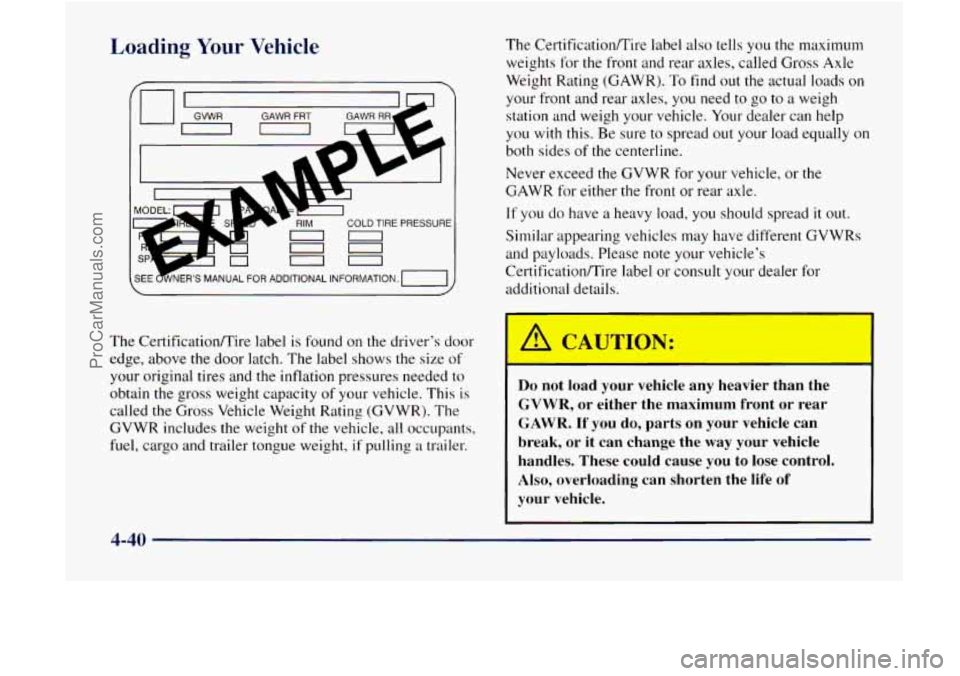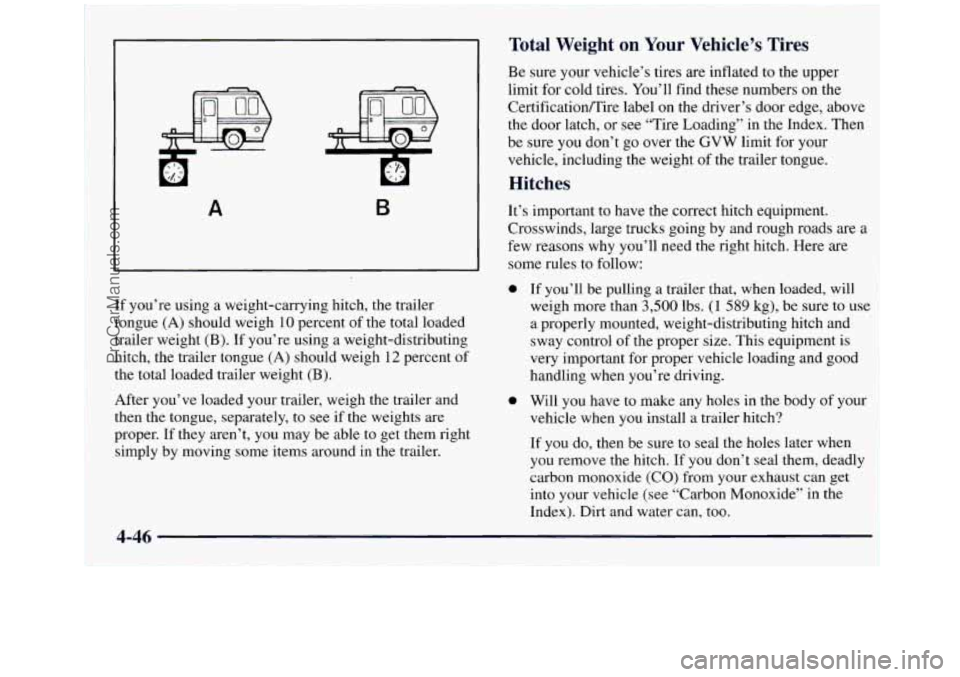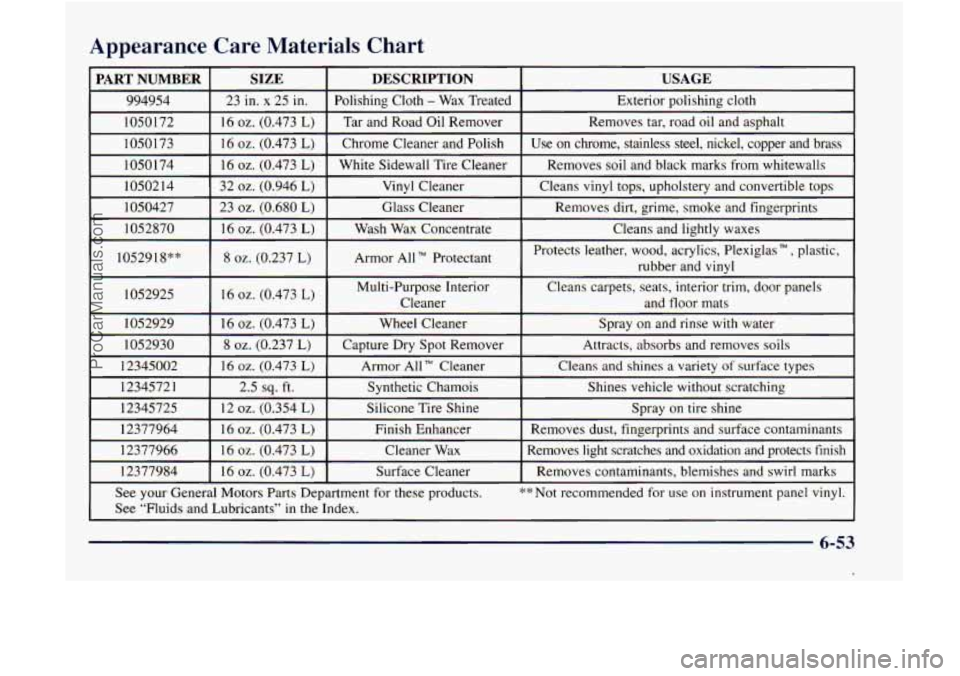1998 GMC ENVOY tire size
[x] Cancel search: tire sizePage 199 of 386

Loading Your Vehicle
The CertificatiodTire label is found on the driver’s door
edge, above the door latch. The label shows the size of
your original tires and the inflation pressures needed to
obtain the gross weight capacity
of your vehicle. This is
called the Gross Vehicle Weight Rating (GVWR). The
GVWR includes the weight of
the vehicle, all occupants,
fuel, cargo and trailer tongue weight, if pulling a trailer. The
Certification/Tire label
also tells you the maximum
weights for the front and rear axles, called
Gross Axle
Weight Rating (GAWR).
To find out the actual loads on
your front and rear axles, you need to go to a weigh
station and weigh your vehicle. Your dealer can help
you with this. Be sure to spread out your load equally on
both sides of the centerline.
Never exceed the GVWR for your vehicle,
or the
GAWR for either the
front or rear axle.
If you do have a heavy load, you should spread it out.
Similar appearing vehicles may have different GVWRs
and payloads. Please note your vehicle’s
Certificatian/Tire label or consult your dealer for
additional details.
I
A (- %I---- - -,
Do not load your vehicle any heavier than the
GVWR, or either the maximum front or rear
GAWR. If you do, parts on your vehicle can
break,
or it can change the way your vehicle
handles. These could cause you to lose control. Also, overloading can shorten the life of
your vehicle.
4-40
ProCarManuals.com
Page 205 of 386

A B
If you’re using a weight-carrying hitch, the trailer
tongue (A) should weigh
10 percent of the total loaded
trailer weight
(B). If you’re using a weight-distributing
hitch, the trailer tongue
(A) should weigh 12 percent of
the total loaded trailer weight (B).
After you’ve loaded your trailer, weigh the trailer and
then the tongue, separately, to see if the weights are
proper. If they aren’t,
you may be able to get them right
simply by moving some items around in the trailer.
1 Total Weight on Your Vehicle’s Tires
Be sure your vehicle’s tires are inflated to the upper
limit for cold tires. You’ll find these numbers on the
CertificatiodTire label on the driver’s door edge, above
the door latch, or see “Tire Loading”
in the Index. Then
be sure
you don’t go over the GVW limit for your
vehicle, including the weight
of the trailer tongue.
Hitches
It’s important to have the correct hitch equipment.
Crosswinds, large trucks going by and rough roads are a
few reasons why you’ll need the right hitch. Here are
some rules to follow:
0 If you’ll be pulling a trailer that, when loaded, will
weigh more than
3,500 lbs. (1 589 kg), be sure to use
a properly mounted, weight-distributing hitch and
sway control of the proper size. This equipment is
very important for proper vehicle loading and good
handling when you’re driving.
0 Will you have to make any holes in the body of your
vehicle when you install
a trailer hitch?
If you do, then be sure to seal the holes later when
you remove the hitch. If you don’t seal them, deadly
carbon monoxide (CO) from your exhaust can get
into your vehicle (see “Carbon Monoxide” in the
Index). Dirt and water can, too.
4-46
ProCarManuals.com
Page 287 of 386

When It’s Time for New Tires
One way to tell when it’s
time for new tires is to
check the treadwear
indicators, which will
appear when your tires have
only 1/16 inch (1.6 mm) or
less
of tread remaining.
You need a new tire if any of the following statements
are true:
0 You can see the indicators at three or more places
around the tire.
You can see cord or fabric showing through the
tire’s rubber.
The tread or sidewall is cracked, cut or snagged deep
enough to show cord or fabric.
0 The tire has a bump, bulge or split.
The tire has a puncture, cut or other damage that
can’t be repaired well because of the size or location
of the damage.
Buying New Tires
To find out what kind and size of tires you need, look at
the Certificationmire label.
The tires installed
on your vehicle when it was new had
a Tire Performance Criteria Specification (TPC Spec)
number on each tire’s sidewall. When
you get new tires,
get ones with that same TPC Spec number. That way
your vehicle will continue to have tires that are designed
to give proper endurance, handling, speed rating,
traction, ride and other things during normal service
on
your vehicle. If your tires have an all-season tread
design, the TPC number will be followed by an
“MS”
(for mud and snow).
If you ever replace your tires with those not having a
TPC Spec number, make sure they are the same size,
load range, speed rating and construction type (bias,
bias-belted or radial)
as your original tires.
6-40
ProCarManuals.com
Page 288 of 386

I Uniform Tire Quality Grading
Mixing tires could cause you to lose control while
driving.
If you mix tires of different sizes or types
(radial and bias-belted tires), the vehicle may not
handle properly, and you could have a crash.
Using tires of different sizes may also cause
damage to your vehicle. Be sure to use the same
size and type tires on all wheels.
If you use bias-ply tires on your vehicle, the
wheel rim flanges could develop cracks after
many miles of driving.
A tire and/or wheel could
fail suddenly, causing a crash. Use only radial-ply
tires with the wheels on your vehicle.
The following information relates to the system
developed by the United States National Highway
Traffic Safety Administration, which grades tires by
treadwear, traction and temperature performance.
(This applies only to vehicles sold in the United States.)
The grades are molded on the sidewalls of most
passenger car tires. The Uniform Tire Quality Grading
system does not apply to deep tread, winter-type snow
tires, space-saver or temporary
use spare tires, tires with
nominal rim diameters
of 10 to 12 inches (25 to 30 cm),
or to some limited-production tires.
While the tires available on General Motors passenger
cars and light trucks may vary with respect to these
grades, they must also conform to Federal safety
requirements and additional General Motors Tire
Performance Criteria (TPC) standards.
6-41
ProCarManuals.com
Page 291 of 386

NOTICE:
The wrong wheel can also cause problems with
bearing life, brake cooling, speedometer or
odometer calibration, headlamp aim, bumper
height, vehicle ground clearance and tire
clearance to the body and chassis.
See “Changing a Flat Tire” in the Index for
more information.
Used Replacement Wheels
I
Putting a used wheel on your vehicle is
dangerous. You can’t know how it’s been used or
how far it’s been driven. It could fail suddenly
and cause an accident.
If you have to replace a
wheel, use a new GM original equipment wheel.
Tire Chains
NOTICE:
Don’t use tire chains. They can damage your
vehicle because there’s not enough clearance.
Use another type of traction device only if its
manufacturer recommends it for use on your
vehicle and tire size combination and road
conditions. Follow that manufacturer’s
instructions.
To help avoid damage to your
vehicle, drive slowly, readjust
or remove the
device
if it’s contacting your vehicle, and don’t
spin your wheels.
If you do find traction devices that will fit, install
them on the rear tires.
6-44
ProCarManuals.com
Page 300 of 386

Appearance Care Materials Chart
PART NUMBER USAGE DESCRIPTION SIZE
994954 Exterior polishing cloth
Polishing Cloth - Wax
Treated
23 in. x 25 in.
1050172
Cleans
and lightly waxes Wash
Wax Concentrate
16 oz. (0.473 L) 1052870 Removes dirt,
grime, smoke
and fingerprints
Glass Cleaner
23 oz. (0.680 L) 1050427 Cleans
vinyl tops, upholstery and convertible tops
Vinyl
Cleaner
32
oz. (0.946 L) 1050214 Removes
soil and black marks from whitewalls
White Sidewall Tire Cleaner
16
oz. (0.473 L) 1050174 Use on chrome, stainless steel, nickel, copper and brass
Chrome
Cleaner and Polish
16 oz. (0.473 L) 1050173 Removes
tar, road
oil and asphalt
Tar and Road Oil Remover
16 oz. (0.473 L)
- ~~
1052918** Armor All TM Protectant 8 oz. (0.237 L) Protects leather, wood, acrylics, Plexiglas TM, plastic,
rubber and
vinyl
1052925
Attracts, absorbs and removes
soils Capture Dry Spot Remover 8 oz. (0.237 L) 1052930 Spray
on and rinse
with water
Wheel Cleaner
16 oz. (0.473 L) 1052929 16
oz. (0.473 L) Multi-Purpose
Interior
Cleans carpets, seats, interior trim, door panels
Cleaner and floor mats
12345002
16 oz. (0.473 L)
See your General Motors Parts Department for these products. **Not recommended for use on instrument panel vinyl.
Removes contaminants, blemishes and swirl marks
Surface Cleaner
16 oz. (0.473 L) 12377984 Removes light scratches and oxidation and protects finish
Cleaner
Wax 16
oz. (0.473 L) 12377966 Removes dust, fingerprints
and surface contaminants
Finish Enhancer
16
oz. (0.473 L) 12377964 Spray
on tire shine
Silicone Tire Shine
12
oz. (0.354 L) 12345725 Shines vehicle
without scratching
Synthetic Chamois
2.5
sq. ft.
1234572 1
Cleans and shines a variety of surface types
Armor All Cleaner
See “Fluids and Lubricants” in the Index.
--
6-53
ProCarManuals.com